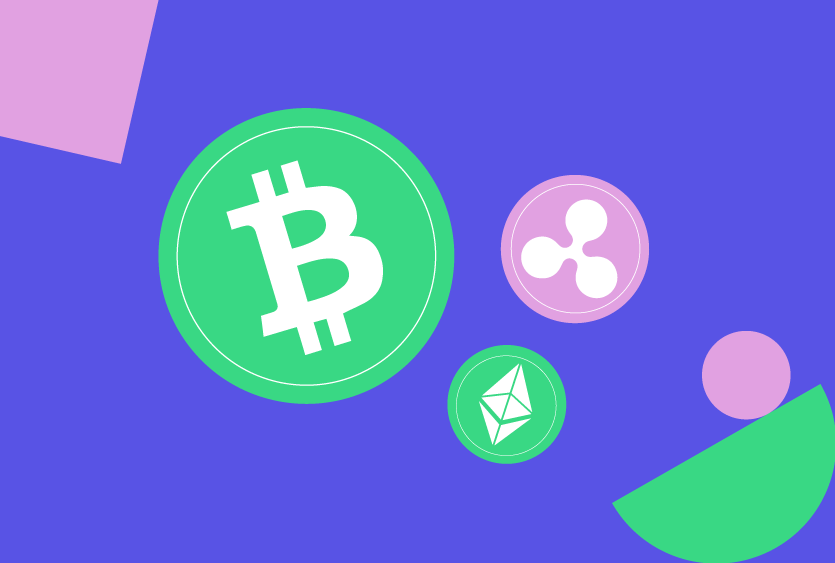Read time 5 mins
Author Sophia 🌱


If you’re new to the world of crypto and are struggling to get your head around how cryptocurrencies work, how they’re created, and whatever a so-called blockchain is, then this is the article for you.
We are going to start right back at the basics, but if you don’t want to read the whole article, then jump to the section you need using the links below:
Cryptocurrency, often called crypto, is a decentralized digital currency based on cryptography. Let’s break that down:
Decentralized: Not issued by a bank, government, or central authority. Crypto is distributed using a peer-to-peer network
Digital currency: Generated and traded electronically
Cryptography: A technique used to secure information by encoding it so that only the intended party can read it
In short, crypto is a digital asset, one which can be bought, traded, and used to buy services or products. All crypto transactions are encoded for security and recorded on a ledger known as blockchain.
Blockchain is the name for the digital ledger on which most cryptocurrencies live. Some cryptocurrencies, like Bitcoin and Ethereum, have their own blockchains, while others are built on top of an existing blockchain.
While blockchain is generally associated with crypto, it has a wide variety of applications and can also be used to track and record goods and services, patents, and contracts, meaning it is rapidly spreading to other industries.
Digital ledger: a digital ledger records and tracks transactions
Blockchain is a fully transparent digital ledger, meaning transactions made on a public blockchain are accessible to anyone. You might assume that this would make blockchain incredibly unsafe, but in fact, the opposite is true.
Blockchain runs on a decentralized network of computers called nodes, which form the basis of its peer-to-peer network.
Nodes: The moderators of the blockchain ledger. Nodes build the infrastructure of a decentralized network. Anyone can set up a node and start verifying and validating blocks in the network
Peer-to-peer: Assets are transferred worldwide without a middleman, central server, on any other form of intermediary. They go from sender to receiver uninterrupted
The widely distributed and self-governing nature of blockchain is what makes it so secure. With so many people monitoring transactions in a ledger, blockchain has made it incredibly difficult for criminals to make fraudulent transactions.
Simply put, the blockchain system is built from data blocks chained together in chronological order - hence the name blockchain.
In the simplest of terms, mining cryptocurrency is the process of creating new crypto ‘coins.’ While some people buy their cryptocurrency, others earn it through crypto mining. For most people, that’s all you need to know, but the process is actually a lot more complicated.
Remember the term cryptography we referenced above? Well, crypto miners have special computers designed to solve the cryptography problems needed to confirm each transaction on the blockchain. If you want to learn more about this process, then take a look at a process called proof of work (PoW).
Essentially, crypto miners validate the crypto transactions by solving mathematical problems, earning a tiny amount of cryptocurrency for doing so. And crypto miners aren’t just individuals; they’re sometimes entire firms!
Businesses such as Bit Mining Limited, Argo Blockchain PLC, and BitFarms Ltd mine crypto on a colossal scale from farms across the globe.
The computers used by PoW crypto miners must complete billions of mathematical problems to verify a single block of transactions. Only then do they earn a small amount of crypto. These machines run day and night, making crypto mining an incredibly energy-intensive process.
Because there’s a lot of money to be made from mining crypto, some crypto miners set up vast warehouses of computers, using massive amounts of electricity to mine cryptocurrency at scale.
While the process of crypto mining itself isn’t anything terrible, the environmental impact of crypto mining is a concern for many people. This has led to the emergence of new sustainable cryptocurrencies and more eco-conscious crypto-mining businesses that are trying to run their operations using hydroelectricity or other sustainable power sources.
If you’re new to the crypto world, it’s easy to be intimidated by the idea of a decentralized network and the negative news headlines marketing crypto as a criminal currency.
But the truth is crypto is no less secure than traditional financial systems and currencies; in fact, like-for-like, fiat is used 800X more for money laundering than crypto, and digital ledgers like blockchain are far better protected against fraud than traditional ledgers.
Fiat: a government-issued currency that is not backed by a commodity such as gold. Fiat gives central banks greater control because they can control how much money is printed. Most modern paper currencies, such as the U.S. dollar, are fiat currencies
That’s not to say that crypto is free from problems. Just like with fiat currency, there are plenty of crypto scams out there, but so long as you’re using a trusted and well-established cryptocurrency, then most of the scams are related to how you hold, send or receive currency, and the key to staying safe is to use trusted crypto exchanges.
A crypto exchange is a platform on which crypto users buy and sell cryptocurrencies. Some crypto exchanges also support the trade of digital assets like NFTs, and there’s a growing number of crypto exchanges that allow users to cash out their crypto as gift cards rather than fiat currency.
NFT: Non-Fungible Token. NFTs are digital assets that represent a real-world object, like art.
NFT’s can be bought and sold online and are generally encoded with the same underlying software as many cryptocurrencies.
There are three main types of crypto exchanges, Centralized Exchanges (CEX), Decentralized Exchanges (DEX), and Hybrid Exchanges (HEX).
You can read more about each type of exchange and its pros and cons here.
Binance, Deepcoin, Hotcoin Global, and Coinbase are just a few of the biggest crypto exchanges, but there are hundreds to choose from.
Centralized Exchange: A CEX is controlled by an authority. Many of the most popular crypto exchanges are centralized. Centralized crypto exchanges have higher liquidity and are often the easiest to use, making them more popular with the masses. But they also require you to entrust your crypto to the exchange’s custodial wallet
Decentralized Exchange: A DEX has a decentralized power structure whereby its users have influence. Decentralized exchanges give users self-custody of their crypto by letting them trade from their personal wallets, but they can be more complicated to use, and liquidity can be an issue
Hybrid Exchange: HEXs share characteristics of both centralized and decentralized exchanges. Many people think that a hybrid model will be the future of crypto exchanges as it aims to provide the liquidity and ease of use of a CEX with the security and autonomy of a DEX
In January 2009, when Bitcoin was first launched, few people would have believed cryptocurrencies would become as popular as they are today.
From 2021 to 2022, the number of cryptocurrencies in existence more than doubled, and there are now more than 12,000 cryptocurrencies in existence. While most of these are nowhere near as successful as Bitcoin, and many never will be, the crypto industry as a whole is booming, and the door is wide open for continued innovation in this space.
Will crypto be the future of payments? Quite possibly.
More than 15,000 businesses worldwide now accept Bitcoin, and a study by Deloitte has revealed that nearly 75% of retailers plan to accept either cryptocurrency or stablecoin payments within the next two years. Not to mention, El Salvador accepted Bitcoin as a legal tender in 2021!
While this all sounds promising, there’s still a degree of pushback from certain brands and businesses, making it difficult for crypto holders to live off their cryptocurrencies without constantly changing them into fiat currency first and paying significant fees in the process.
Until more businesses accept crypto as a means of payment, crypto users must cash out their crypto into fiat currency before using it for everyday goods or services.
Transforming crypto into fiat currency through a crypto exchange often incurs fees, and the process can take hours or even days to complete.
With fierce competition, there's a clear need to build greater flexibility into the exchange process, and one way of doing so is by giving consumers the option to cash out their crypto onto a digital gift card of their choice.
By cashing out crypto onto digital gift cards, consumers can get more value from their transfers. The gift cards they’ve ordered are available instantly, without fees or tax implications, making them a win-win for both parties.
Get in touch with us today to learn more about how Tillo empowers crypto exchanges with digital gift cards.







